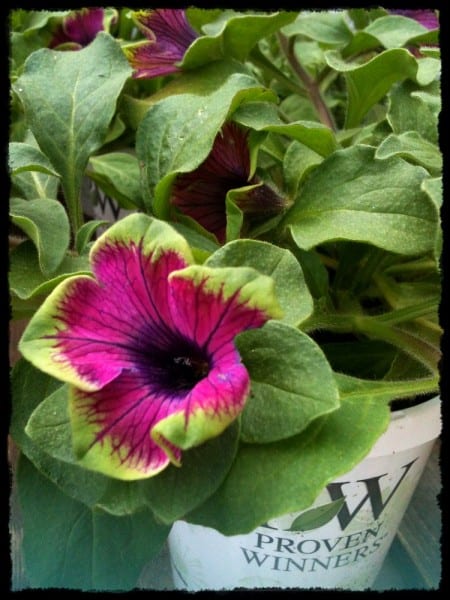Welcome to the second installment of our Container Garden Mini-Series. Yesterday I talked about commitment issues. If you’re a commitment-phobe, container gardening is probably not for you. You can click here to read why:
Today’s topic?
Water!
Depending on what type of plants you purchase, whether your containers are in sun or shade or partial sun, and of course how hot or cool the weather is, all contribute to how much water your plants will need.
The biggest reason container gardens fail is lack of water. It happens. And depending on where you live geographically, and the weather, just a few days without water and your container gardens might not bounce back.
How much do you water? I’ve read a zillion different guidelines in various books and online… well, maybe not a zillion, but you get my point. The simplest thing to remember is this: regular watering keeps your plants happy. Depending on what type of plants you purchase, whether your containers are in sun or shade or partial sun, and of course how hot or cool the weather is, all contribute to how much water your plants will need. That’s not necessarily the answer you were expecting, right? Honestly, there’s no tried-and-true formula for containers, such as 1 cup of water every so many days.
Plants and flowers will wilt and droop when they need more water, which means the plant is stressed out. (I don’t know about you, but when I get stressed out it is not a good thing.) Yes, the plants will bounce back with a good watering. But if your plants repeat this (wilt then happy, wilt then happy) a few times, it becomes more difficult for the plant to remain healthy.
Water deeply.
When you water, water deeply. If you just water enough that the top layer of soil gets wet, you haven’t watered deeply. You need to water enough so that the water seeps down all the way to the root system. Yes, water will probably come out of your containers a bit, which I don’t have a problem with. (If you do, use a saucer underneath to catch the water. Most containers either have these built into them, or have corresponding saucers that you can match up and purchase separately.
Where I live – in southern New Jersey – our Summers get hot and humid. And hotter and more humid as the Summer progresses. Once that hot and humid phase kicks in, I water my containers daily and deeply. And they stay happy. It takes some trial and error, and if you’re new to container gardening you will get to know your specific plants’ habits as to how much water they need.
Water in the morning.
When you water your plants in the morning, there is much less chance of any mildew or disease or pests bothering your plants. Plus, during a hot and sunny day, the plants are already fortified with water and can handle the heat without any drooping, wilting or moping. Ok, maybe not moping, but that is what I think flowers look like when hunched over.
The second best time to water your plants is in the afternoon. This still provides enough time for the water on any part of the plants to evaporate before the evening sets in. You want your plants to be as dry as possible during the night. (Of course, if it rains at night…well, all bets are off!)
If you have absolutely no choice but to water in the evening, then make every effort to aim the water at the root system – i.e. the dirt – and try not to get any water on the leaves. This is especially important for vegetables which can easily develop a powdery mildew or mold if damp conditions are just right.
Don’t stress.
Most importantly, don’t stress over the watering. Gardening is a learning process, yes, but I think of gardening more as therapy. It feels good to tend to the flowers and vegetables and enjoy the blooms and fruits (literally!) of your labor. Container gardening can be a lot of fun with some joy mixed in, as long as you don’t take yourself too seriously. (Of course that statement can hold true for many things besides gardening, right?)
An extra tip for today:
Almost all outdoor pots have at least one drainage hole at the bottom, so that water doesn’t sit in the pot causing mold, mildew, disease. However, if you don’t cover the hole with porous material, more than just water will seep out of the bottom. You can purchase landscape fabric at the home improvement or hardware stores, or you can simply use coffee filters (unused ones!) or paper towels ripped or folded to size to prevent dirt from leaving your pots.
Part Three in this mini-series: Fertilizing your container gardens.
~Laura


I am loving your gardening tips, we are contemplating starting a vegetable and/or herb garden. But as much as I love the flowers, veggies, and such I don’t really care to get into the “dirt” of it LOL. Fortunately for me, my Hubby to be LOVES it! Hailey loves to get dirty too. They are starting to convert me though because it is a lot of fun to garden with them. I have to tell him about watering the plants at night, that is when he waters, and I’m not sure if he “skips the leaves” or not.
Trust me on this Kim: once you begin to see the results of your gardening – flowers blooming, tasty veggies growing, savory herbs for cooking – you will enjoy it too! Gardening is something I do with my husband, and it makes for some good stories whether we’re successful with a project or we botch it up! LOL (Oh – and…um… I get pretty dirty out there… and I mean that dirt-wise, not character-wise! LOL)